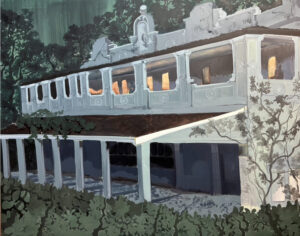
At the heart of this exhibition is the sense of history that is intimate and personal. It enabled the artist to extend these sentiments to discourse what is political without it enveloping what is delicate about personal history.
Themba Tsotsi about the work of Ravelle Pillay
Ravelle Pillay
History hammered by time
South African painter Ravelle Pillay has an exhibition at the Goodman Gallery in Cape Town. The exhibition runs until March 2024.
This is her first solo exhibition with the gallery, it is a nostalgic collection of works that the artist utilises to examine her family history, colonial impact and poetic implications of representation that connote the artist creative goals. Sentiment and perspective in this exhibition were utilised to articulate a measure of history that is personal and rooted in reflection as cathartic and healing.
The firstborn (interlopers), 2023
This can be discerned in the piece titled “The firstborn (interlopers)“, an image comprised of a colonial style house with arches lining up the front porch. The image is stagnant evoking thoughts of a time capsule, a haunting and a reconciliation. Farm homes hold stories of the past, Pillay made the structure imposing, dominating the canvas, with the measure of mystery that can permeate homes of this nature. It is a white grey image with a red porch. It resounds with history in its small space, and contemporary measures in the painting’s rediscovered weight. The work embodies the themes of the exhibition, a latent narrative of realism as a representational theme with, a fictive escapism of sentiments encased in family photos and memories.
Queen and Country (The Healers(, 2023
The colonial theme continues with the work titled “Queen and country (the healers)”. This image comprises a battalion of soldiers of Indian descent serving in the British army. History in this exhibition functions as a mean to consolidate the impact of colonialism. It is a measure to recover severed stories and individuals. The subtitle ‘the healers’ speaks to the dignity to reconcile the loss those individuals became subject to and the impact it had on their families. Pillay speaks to a generation without being limited to a particular period. Rather she transcends time, imbuing the images of her work with an immanence through art as a means to express memory, as a means to heal.
Airs, 2023
“Airs” is a piece that operates with a measure of a memory. It is a depiction of hedge fencing a home whose spiers rise high in the background. The work is like a stagnant flash of memory, a solid recollection of a spot that, when it is related to the past, justifies the sentiment about what is lost. When it’s related to the present it pronounces the sense of void and loss that history has impose in the artist family history. It is finished in a pale green with dark green patches of vegetation, almost as if the artist is speaking about stagnation as rotting and disintegrating memories. Pillay is conscious of the ways time is measured yet has implications outside of contexts. This is reflected in the high rising house in the background of the bramble depicted in the foreground. The house is symbolic of a longevity that anchors disappearing and disintegrating narratives. This is a subsumed by the nature of time and fickleness of memories.
At the heart of this exhibition is the sense of history that is intimate and personal. It enabled the artist to extend these sentiments to discourse what is political without it enveloping what is delicate about personal history. That measure is latent in the collection. In the piece “Airs” for example, places and spaces of nostalgia that are empty become a means for cumulative recollection. In “The firstborn” they are symbolic and impose a sense of intimacy that is a thread to a sense of loss and desire for recovery.
This latency is also a means to imbue the aesthetic of realism in the work with veracity of morality in the impact of colonialism and Pillay ‘s personal narrative being part of bigger one. But through the intimacy of her past. This is depicted in the velvety black and Marrone of the work titled “The gates”. Serene and gloomy, murky and illuminated by the background of the house. It is a work that denies the disintegration of memories.


